How many bricks are in 1 sq. m of masonry?

In private households, it is periodically necessary to make an extension, bulkhead, garage or bathhouse. Brick is the most appropriate choice as a building material.
A silicate or ceramic building element is suitable for different types of buildings. At the very beginning of construction, an urgent question arises: how much building material is required to build an object, taking into account the percentage of scrap.
It is difficult to buy material without a cost estimate. If it is not calculated correctly, then in case of a shortage, there will be an overspending of funds for transport, since you will have to buy and transport the missing material. In addition, very often bricks from different batches differ markedly in shades. And extra material is also useless, if no other buildings are planned.


Standard product sizes
If the wall is one fourth thick, then 1 sq. there will be only 32 pieces per meter. bricks, if you do not take into account the dimensions of the joints, and taking into account the mortar joints, 28 bricks are required. On the website of many companies there are electronic calculators that allow you to accurately calculate the amount of required building material.
The seams play an important role, their size should not be neglected in any way. If the object is very large, then in total they can occupy a significant area. Most often, vertical seams will be 10 mm, horizontal seams 12 mm. Logically, it is clear: the larger the building element, the fewer seams and mortar will be required for the masonry. The wall parameter is also important and essential, it depends on the masonry technology. If you correlate it with the parameter of a building element, then it will not be difficult to calculate: how much one and a half, front or single will be needed to erect one square meter of the wall.


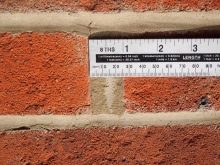
The standard dimensions of building elements are as follows:
- "Lorry" - 250x120x88 mm;
- "Kopeck piece" - 250x120x138 mm;
- single - 250x120x65 mm.
Brick parameters can vary, so in order to know exactly how much material is needed for one "square", it will be necessary to estimate the exact dimensions.
For example, one and a half is needed in the amount of 47 pieces, and 0.76 (thin) will be needed in the amount of 82 pieces.


Types of masonry.
The thickness at the walls of the object can vary quite significantly, taking into account the cold winters in Russia, the outer walls are two bricks thick (sometimes even two and a half).
Sometimes there are walls that are much thicker than generally accepted standards, but these are only exceptions that prove the rules. Thick walls are usually measured in cubic quantities, masonry is half a brick and even one and a half - measured in square meters and centimeters. If the wall contains only half of the building element, then only sixty-one bricks are required per unit area of 1 square meter. meter, if with seams, then it will be fifty-one. There are several types of masonry.
- Half brick - 122 mm.
- One-piece - 262 mm (taking into account the seam parameter).
- One and a half 385 mm (including two seams).
- Double - 512 mm (if we take into account three seams).
- Two and a half - 642 mm (if you count four seams).

Let's analyze the masonry half brick thick. Taking into account the four bricks and the seams between them, it will come out: 255x4 + 3x10 = 1035 mm.
Height 967 mm.
Parameter of masonry, which has a height of 13 pcs.bricks and 12 gaps between them: 13x67 + 12x10 = 991 mm.
If you multiply the values: 9.67x1.05 = 1 sq. meter of masonry, that is, it turns out 53 pieces. taking into account the seams and the possibility of the presence of defective specimens. This figure can be taken as a basis for calculating the calculations of other types of structures made of ordinary bricks.
When using two types of masonry, you can simply multiply the figure that was obtained:
- Two elements 53 x 4 = 212 pcs.
- Two and a half elements 53x5 = 265 pcs.
In this case, the parameters of the seams are taken into account.


Methods for calculating the amount of building material
Brickwork assumes that there are generally accepted standards for marriage, it is up to 5%. The material deforms, splits, so it is necessary to take building material with some margin.
The thickness of the wall is always determined by the number of elements that must be consumed.
To make it more clear how much material should be consumed, you can see the different types of masonry. The numbers that will be given below will also take into account the thickness of the seams; without this parameter, it will not be possible to adequately calculate the amount of materials.
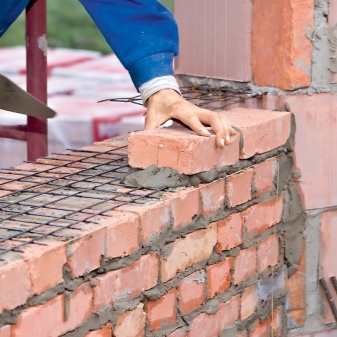
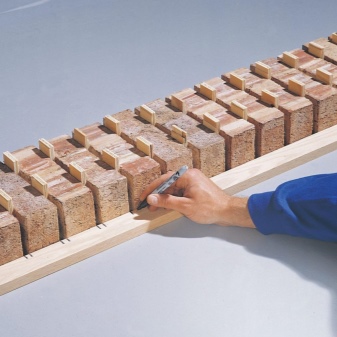
If the wall is 122 mm, that is, half a brick, then in 1 sq. meter there will be such a number of bricks:
- single 53 pcs.;
- one and a half 42 pcs.;
- double 27 pcs.

To make a wall 252 mm wide (that is, one brick), in one square then there will be such a number of materials:
- single 107 pcs.;
- one and a half 83 pcs.;
- double 55 pcs.
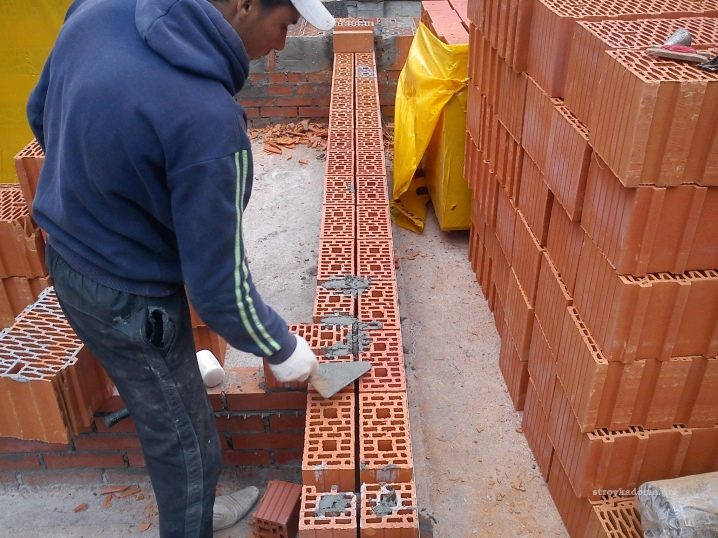
If the wall is 382 mm wide, that is, one and a half bricks, then in order to fold one square meter of the wall, you will need to spend:
- single 162 pcs.;
- one and a half 124 pcs.;
- double 84 pcs.
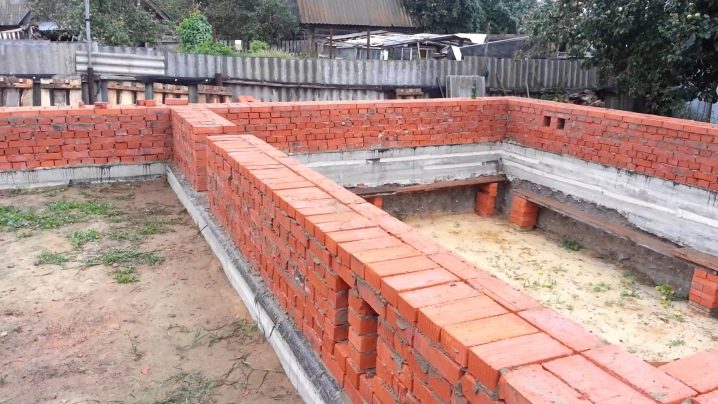
To fold a wall 512 mm wide (that is, into a double brick), you will need to use:
- single 216 pcs.;
- one and a half 195 pieces;
- double 114 pcs.
If the wall width is 642 mm (two and a half bricks), then you will need to spend 1 sq. meter:
- single 272 pcs.;
- one and a half 219 pcs.;
- double 137 pcs.
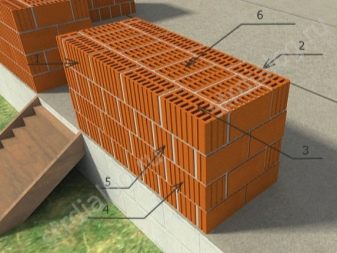

Factors affecting the number of bricks in a masonry
In order to correctly calculate the material, you should know the rates of material consumption and have a special calculation table in front of your eyes.
The design parameters are taken into account as the basis for the calculation. If the masonry is made in half a brick, then the wall will be 12 cm thick.If the masonry is double, then the wall will be at least 52 cm thick.
The parameters of the seams are calculated taking into account the number of bricks that will need to be folded into 1 sq. m (this does not take into account the thickness of the seam of the masonry itself).

Calculation of the required quantity
To correctly determine the amount of building material required for masonry, you should calculate how many pieces of bricks are in 1 sq. meter. It should be borne in mind which masonry method is adopted, as well as the size of the brick.
If, for example, a masonry of two bricks is required with a one-and-a-half product, then there will be 195 pieces in one square meter. taking into account the battle and excluding the cost of seams. If we count the seams (vertical 10 mm, horizontal 12 mm), then the bricks are estimated to be 166 pieces.

Another example. If the wall is made in one brick, then, without taking into account the parameter of the seams, 128 pieces are used for one square (1mx1m) of masonry. If we take into account the thickness of the seam, then 107 pieces are required. bricks. In the case when it is necessary to create a wall of double bricks, it will be necessary to use 67 pieces without taking into account the seams, taking into account the seams - 55.


Taking into account the seams
In the event of a change in the specified data upward, material overruns or the appearance of defective connections between building elements will inevitably follow. If you make a wall or bulkhead one brick thick, then you will need at least 129 pcs. (this is without taking into account the seam). If it is necessary to take into account the thickness of the seam, then 101 bricks will be needed. Based on the thickness of the seam, you can estimate the consumption of the solution required for masonry. If the masonry is made with a parameter of two elements, then 258 pieces will be needed without seams, if we take into account the gaps, then 205 bricks will be needed.
When calculating the parameters of the seam, it is necessary to take into account: one cube of masonry accounts for the seam width by a factor of 0.25 of the total volume. If you do not take into account the thickness of the seam, then there may be an overspending of material or its shortage.


Excluding the seam
The brick can be calculated without taking into account the size of the seam, this is sometimes necessary if you make a preliminary calculation. In any case, if you make more accurate calculations, you will have to take into account the coefficient of consumption of the solution from the entire volume of the masonry (0.25).
Calculation table for the required number of bricks.
| P / p No. | Type and size of masonry | Length | Width | Height | Number of bricks per piece (excluding seams) | Number of bricks per piece (taking into account seams of 10 mm) |
| 1 | 1 sq. m masonry in half a brick (masonry thickness 120 mm) | 250 | 120 | 65 | 61 | 51 |
| 2 | 1 sq. m masonry in half a brick (masonry thickness 120 mm) | 250 | 120 | 88 | 45 | 39 |
| 3 | 1 sq. m of masonry in one brick (masonry thickness 250 mm) | 250 | 120 | 65 | 128 | 102 |
| 4 | 1 sq. m of masonry in one brick (masonry thickness 250 mm) | 250 | 120 | 88 | 95 | 78 |
| 5 | 1 sq. m of masonry in one and a half bricks (masonry thickness 380 mm) | 250 | 120 | 65 | 189 | 153 |
| 6 | 1 sq. m of masonry in one and a half bricks (masonry thickness 380 mm) | 250 | 120 | 88 | 140 | 117 |
| 7 | 1 sq. m masonry in two bricks (masonry thickness 510 mm) | 250 | 120 | 65 | 256 | 204 |
| 8 | 1 sq. m of masonry in two bricks (thickness 510 mm) | 250 | 120 | 88 | 190 | 156 |
| 9 | 1 sq. m masonry in two and a half bricks (masonry thickness 640 mm) | 250 | 120 | 65 | 317 | 255 |
| 10 | 1 sq. m masonry in two and a half bricks (masonry thickness 640 mm) | 250 | 120 | 88 | 235 | 195 |

Calculating the wall area
In one cubic meter there are 482 pieces of red bricks, the size of which is 25x12x6.6 cm. The unit of measurement is cube. m universal, it is easy to operate with it. When buying material with a similar size, it is very convenient to use. To have an idea of how many cubes of material will go away, you need to know how thick the object will be, its walls, how many brick cubes will be needed to create. Calculating the wall area
The calculation takes into account the number of storeys, what kind of floors will be. It should be well understood.
The total amount of the area of the wall in length and height is taken. The number and area of openings is counted, which is added up and minus from the total initial amount. Thus, a "clean" working area of the wall is obtained.


Do not forget about the stock
The size of a building element that can be split or deformed is on average 5% of the total. This factor must be taken into account.

Buying bricks with a reserve allows you to save on transportation costs, because if 100 bricks are not enough, you will have to order a vehicle for the delivery of building material again.
For information on how many bricks are in 1 square meter of masonry, see the next video.













The comment was sent successfully.